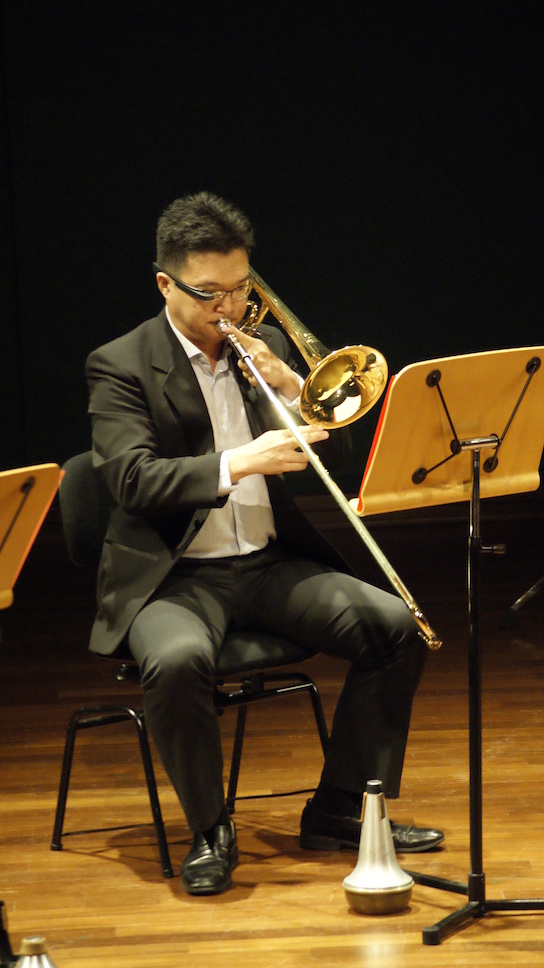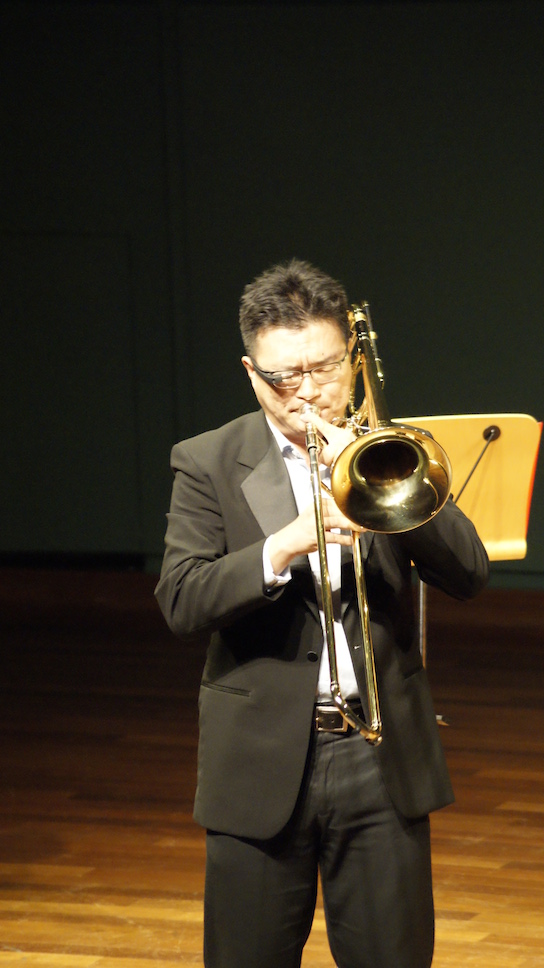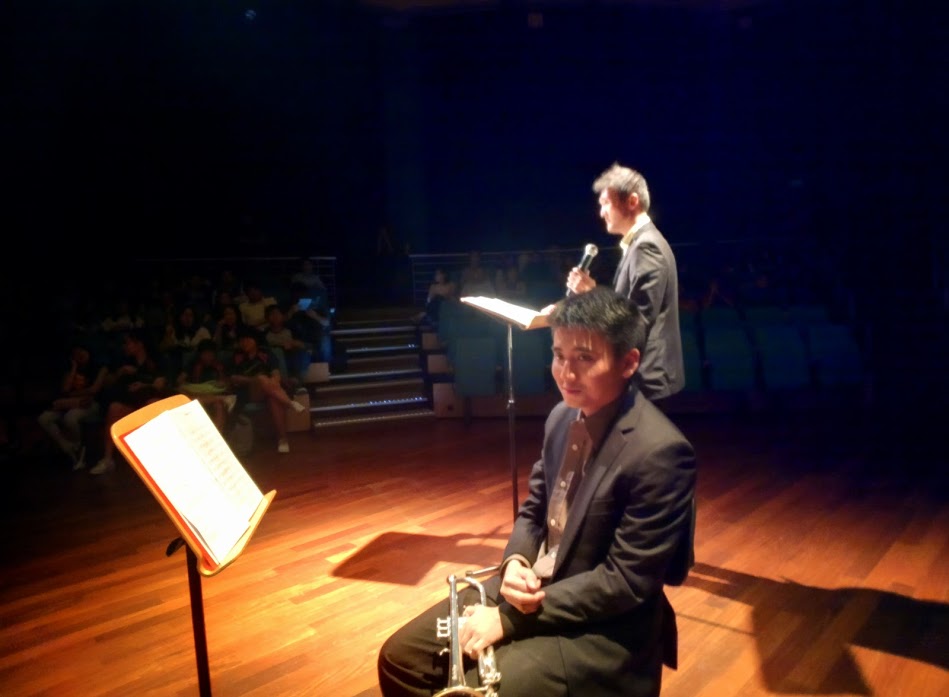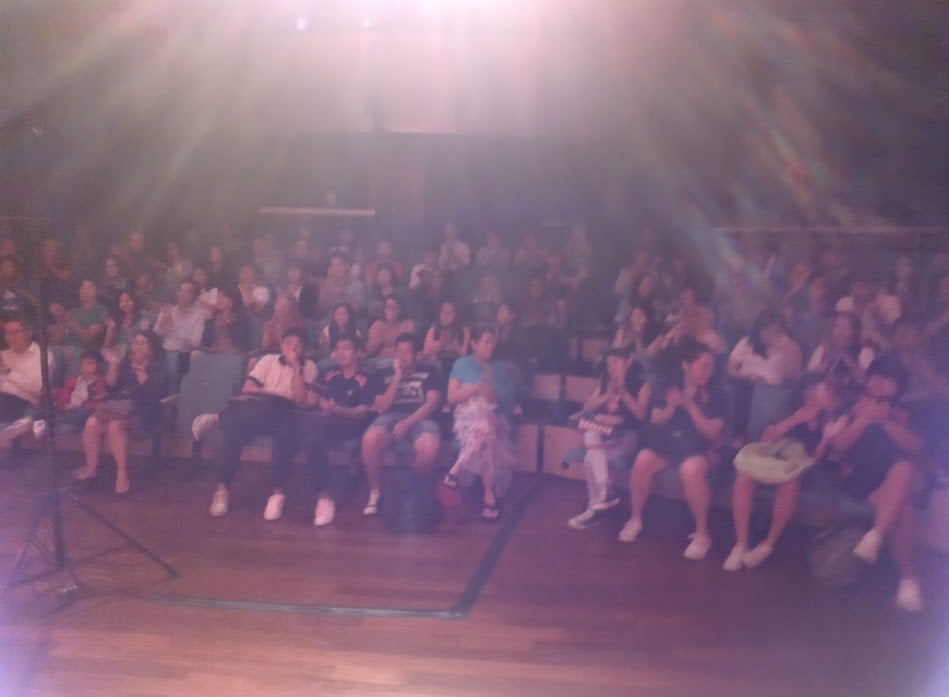What I learned about performing with Glass
Besides doing field work and playing with baby hands free, one of my original aim for acquiring Google Glass was to make it useful for the live performing musicians.
But like building any new app / product / service, I didn’t quite settle with the use case. It was too small for scores, but actually have enough pixels for something other than just pictures. But it was also hard to focus both beyond the screen and on the screen at the same time.
So I thought maybe I actually need to start performing with Glass to learn more. My brass quintet’s recital last Monday was the perfect opportunity for me to give the vanilla version of the product a spin. Here’s how I look sitting:

Here’s a typical sitting position for most classical musicians on stage whether it’s a small group or a large orchestra. I learned a few things that night:
- Sweat makes you feel Glass more. When I’m playing with baby or out doing field work, I don’t sweat as much as I do on stage, as performing in brass quintet is an intensive exercise for me. Being “aware” of Glass possibly affected my concentration.
- View from audience of my facial expression was obstructed. Partially due to my position to the audience in that setting, but as you can see, even supposedly the darkest colour of Glass would shine brilliantly under stage lights. I was hoping that buying charcoal colour would blend with my hair, but it didn’t work.

Here’s a typical standing position, common in small ensemble or soloist playing concertos with any type of accompaniment. More observations:
- Scores are quite redundant in these scenarios. One would have memorised the solo, or even if the soloist needs, he or she would need to leave it and have direct eye contact with the audience. Glass prevents that eye contact from happening as the distance between a typical audience and the performer is much further than face to face conversations.
- Concentration of the audience would also drift due to an unfamiliar novelty attached to their favourite musician. Usually a costume or any kind of attire does not obstruct the face of the performer on stage, as that’s the visual attachment and body language that goes with the music. So unless I wear Glass in all my publicity material and is known as _the_ Glass Trombonist, this is going to distractify.

During the show, there are a million things that we rehearsed that we have to do, thus naturally Glass is the last thing I remembered. I was overwhelmed despite being throughly prepared, because as typical amateurs, there will be situations during concerts that we have never anticipated. And we need to react very quickly.
Thus, this shot above was the only shot I manage to take using Glass during the show, and it was during the longest reprieve moment when I got a break from my emcee duty and was resting for the next item. Also notice that:
- Lighting conditions are all wrong for the purpose of capturing a view of the audience, because typically the house is dark, while the stage is bright. Audience on the other hand gets a pretty picture of us (but not allowed to due to rules set by the hall). So there’s no way of my taking a picture of my wife and daughter even if they could come, unless it was done before/after the concert or during intermission.
- Sharpness of the image suffers too because on stage we often use these tungsten-halogen lamps that somehow creates these diffused lighting around, as compared to natural lighting conditions where Glass works flawlessly.

The glare was evident with the final shot – this last picture was taken after the very end during curtain call.
And so surprise surprise even though I kept telling myself to capture just one segment of video, even if it’s 10 seconds, during the show, it did not happen!
Just like an instrument, using Glass well means practise practise practise. Like many classical musicians, our zenith in playing comes after we overcome the technical challenges of producing a good sound at the right time right place, so that our minds can be focused on communicating with the audience. Thus it’s unfair that I had at most 25 minutes of “practise” of using Glass during rehearsals, vs 25 years of practise on my trombone.
Yesterday when I was putting these cameraman photos onto Facebook, I also realise that their face detection algorithms fails to detect all my faces when I upload pictures. The “face” is no longer a face in essence, what a bummer.
So is there still hope in making this a useful gear for performance? I still think so, because there are certain concepts that I couldn’t test, for example, remote controlled image taking and video recording (I might be wearing the Glass, but my cameraman is the best person to judge when I have a great view), and other show elements (such as live broadcast of the show on projector or elsewhere).
And of course there’s also that score reading thing that still bugs me – can I read 1 stave of music that follows my playing? Can I read chords and lyrics only for singers / guitarist? Looking forward to the next round of testing during Christmas season 🙂
End notes: it’s actually great for fooling around backstage!
